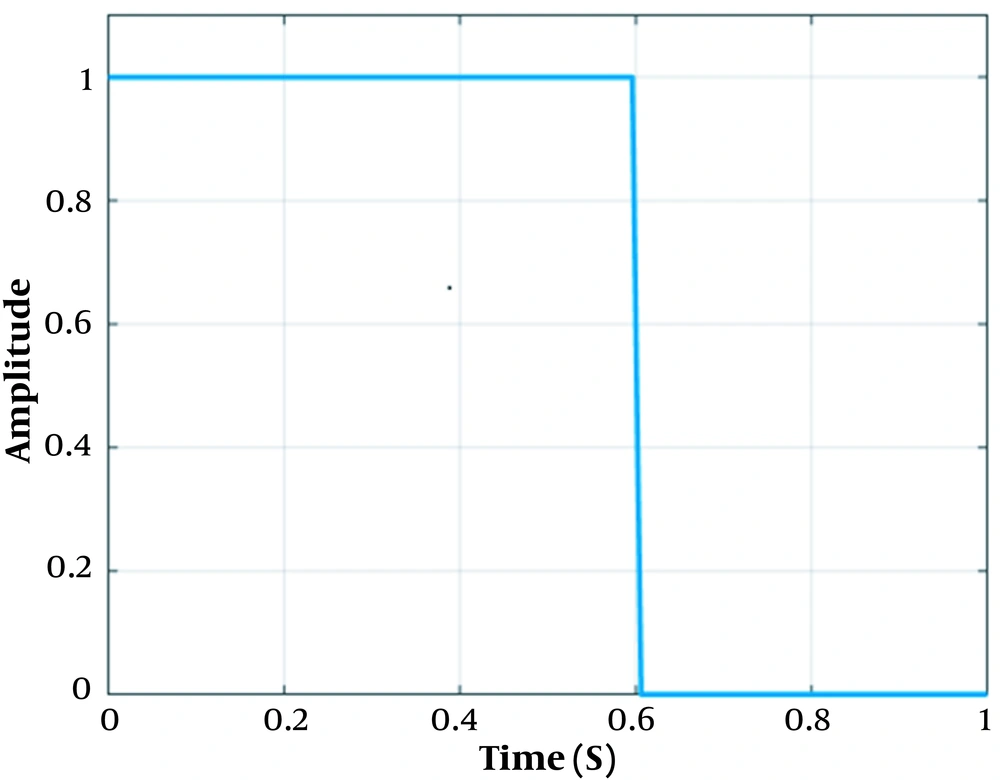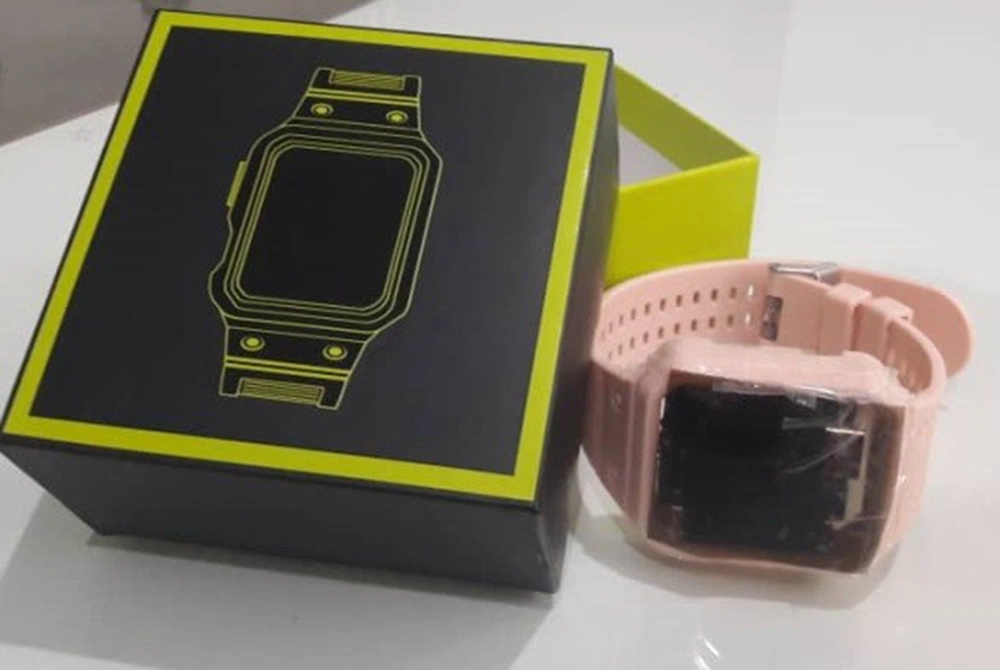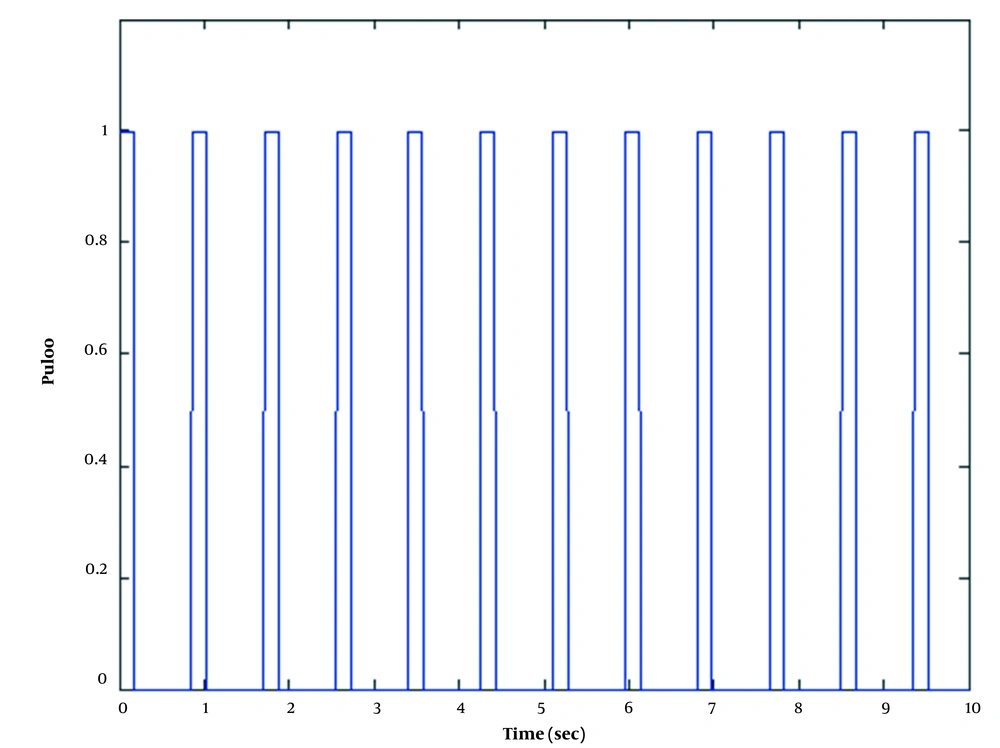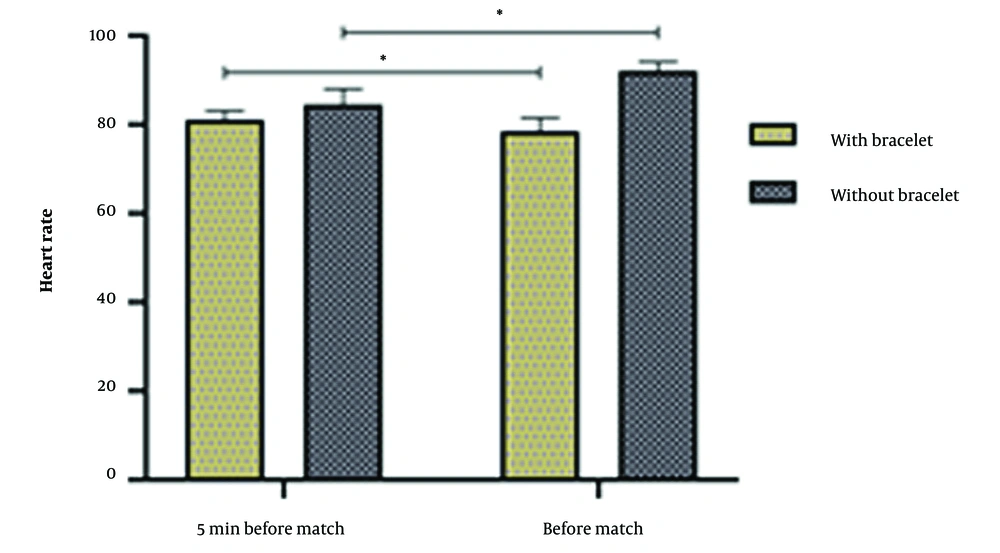1. Background
Anxiety disorders are one of the most common mental health concerns in people’s current lifestyle (1, 2) and make their health and social performance in danger (3). There are many traditional psychological procedures to control anxiety and stress, such as breathing techniques and muscle relaxation. Besides, some techniques utilize sensory input to control their attention and reduce anxiety (4). Anxiety affects the autonomic nervous system and increases the heart rate through sweating (5). Anxiety deals with negative effects on emotional outcomes and mental activities (6). Also, anxiety simultaneously affects the body and mind. Anxiety widely affects athletes’ performance (7) and leads to slowing their movements and reactions. Moreover, it drastically reduces mental activities, like memory and attention. On the other hand, it makes muscle contraction which causes muscles hard to perform the simplest movements, especially for athletes (8). Other anxiety side effects are sensitivity to environmental disturbances and losing attention, like audiences’ reactions (9). Also, it likely increases heart rate and blood pressure (10).
Among different types of physiological markers, heart rate is the most relevant neurobiological marker of the autonomic nervous system (ANS), so the increase in the hate rate is associated with a wide range of negative psychological events (11). Self-regulating and controlling heart rate variability is a non-invasive treatment for patients who suffer from anxiety and restoring autonomic hemostasis (12). This type of treatment is useful for many types of stress-related disorders, for instance, sleep disorders, asthma, anxiety, etc. Controlling the heart rate causes cardiovascular hemostasis and reduces the effects of anxiety and stress (13). Many published studies are related to the effects of heart rate on stress-related disorders. Most of them used heart rate as an index to predict the physical outcome of anxiety disorders (14-16).
Stress and fear of competition are always formed in humans before being challenged. Controlling this feeling significantly affects the outcome of the work. Athletes’ mental state plays an essential role in their performance. Stress begins when athletes doubt their ability to cope with the situation. This stress sets the stage for stress. Successful athletes are those who enable to turn their stress into excitement and turn their threats into an opportunity (17). Athletes experiencing high levels of anxiety endure problems such as poor performance, muscle soreness, and aggression during the competition, Ampofo-Boateng (18) reports. Besides, many researchers assume that errors in execution are due to cognitive anxiety. When competition begins, it is commonly believed that physical anxiety is dramatically decreased, while mental anxiety is increased or decreased based on the type of event taking place. Research shows that athletes use task-focused strategies to achieve their athletic goals. In other words, physical anxiety increases physiological changes along with high arousal, heart rate, blood pressure, respiratory rate, and facial flushing. At the same time, emotion-focused strategies increase cognitive anxiety, anxiety, lack of self-confidence, and feelings of humiliation (19). Wearable technology refers to information technology (IT) devices that people wear on their wrists, arms, or heads. Advancing wearable technology and rising consumer demands deeply influence the healthcare industry. It is expected that people’s demands are increased for products and services by using digital health technology. Rising these demands has made investments and world startups increase. The wearable health technology market is raising, and its maturity will provide consumers with more wearable technologies. Based on the studies, the number of fitness and health soft wares users will be 84 million by 2023 (20).
The wearable device designed and used in this study reduces the heart rate in the pre-race time by stimulating the parasympathetic nerves and making pulses in the radial pulse of the hand, which is the resting heart rate according to the rhythm.
2. Objectives
The purpose of using this device is to decrease athletes’ stress and heart rate before their competitions.
3. Methods
3.1. Wearable Device
The process of designing and producing this wearable device has been as follows:
(1) The pulse is designed in such a way that the pulse acts as a resting heart rate. Hence, a vibration pulse with a frequency of one Hz with a working period of 60% was applied (Figure 1).
(2) A coin-vibrating motor used for the desired mechanical transmitter in this device was the particular design of this bracelet.
(3) The electronic circuit, including an oscillator, battery, USB Type-C charger, and power amplifier, was designed, in which its printed circuit was made as SMD.
The figure shows the final size of the device is designed in military size, in which all the parts are placed in a circuit 3 cm long and 2 cm wide to fit the bracelet shown in Figure 2. This bracelet induces mechanical waves in the form of pulses at 60 bits per minute, and the waveform of these mechanical waves in 10 seconds is shown in Figure 3.
(4) This bracelet is equipped with a microcontroller placed on the skin of the wrist and creates a mechanical pulse of 1 Hz with a duty cycle of 60%.
3.2. Practical
The present study was quasi-experimental. There were two groups with bracelets and without bracelets. Before conducting the research, the essential ethical permission was obtained from the Medical Ethics Committee of Mazandaran University of Medical Sciences (Ethics Code IR.MAZUMS.REC.1399.804), and the invention has been patented in the Intellectual Property Center system with the address (ipm.ssaa.ir).
In this study, the evaluation approach is based on the principles of the GRADE system consisting of grading of recommendations, assessment, development, and evaluation for rating the quality of evidence accepted by organizations worldwide (20).
All participants were given written informed consent to take part in this study. Sixteen female taekwondo practitioners were enrolled based on the following inclusion criteria: (1) people with two years of experience in this field. (2) the participants were aged 14 to 16 years old. (3) they were chosen based on the questionnaire Dos scores for anxiety (0 - 7) and stress (0 - 14). Exclusion criteria: (1) people with a history of taking anti-anxiety drugs were excluded from the study. (2) people with a history of unstable angina pectoris, uncompensated heart failure, or complex ventricular arrhythmias were excluded from the study.
One participant was excluded from the study due to her problems. Then the subjects’ age, height, weight, and heart rate were recorded before conducting the research. Finally, individuals were randomly divided into groups without bracelets (7 people) and with bracelets (8 people). The research method was as follows: First, it was announced by the Taekwondo sports board for the provincial competitions ‘selection.’ Next, it was determined when and where the competitions were held. Then, athletes were necessarily trained on how to use the bracelet. In addition, participants didn’t know anything about the bracelets’ usage. In both groups, heart rate was measured and recorded 5 minutes before and after the start of the match. This study measures heart rate according to the Beurer PM80 model made in Germany. In this study, the Shapiro-Wilk test was used to determine the normal distribution of the data. Moreover, descriptive statistics were utilized to describe the characteristics of a data set. Also, the inferential statistics section used analysis of covariance (ANOVA), the correlated t-test, and the Bephroni post-hoc test. It is noted that SPSS software version 22 was used to analyze the statistical tests in which its significance level was P < 0.05.
4. Results
The individual characteristics of the subjects (which are described by using descriptive statistics of mean and standard deviation) are presented in Table 1. Based on the results, it is clear that there is no significant difference between the groups in age, height, weight, and resting heart rate.
| Variables | With Bracelet | Without Bracelet |
|---|---|---|
| Age (y) | 15.12 ± 0.83 | 14.71 ± 075 |
| Weight (kg) | 53.62 ± 6.2 | 52.85 ± 8.11 |
| Height (cm) | 168.75 ± 3.91 | 167.85 ± 2.19 |
| Rest heart rate (bpm) | 78.50 ± 2.56 | 79.23 ± 3.77 |
Individuals Characteristics
Heart rate values with and without bracelets are shown in Table 2 and Figure 4. The statistical analysis of the data resulted that the pre-test values of both groups (with bracelets and without bracelets) were not significantly different from each other. According to Table 2, The ANCOVA used for Post-test values indicated that there was no significant difference between the two groups in heart rate values (P < 0.05 between groups). The results of the correlated t-test showed that there was a significant difference between the two groups in heart rate at 5 minutes and immediately before the competition (intragroup P < 0.05). The results of the post hoc test in Table 2 showed that there was a significant difference between the two groups in heart rate values (P < 0.05).
| Variable | 5 Minutes Before the Match | Before Match | P-Value | |
|---|---|---|---|---|
| Intragroup | Intergroup | |||
| Heart rate | 0.000 | |||
| with bracelet | 81.00 ± 2.07 | 78.50 ± 2.00 | 0.000 | |
| Without bracelet | 84.42 ± 4.54 | 92.14 ± 5.01 | 0.000 | |
Results of ANOVA and Paired t-tests for Intra-group and Inter-group Comparison of Heart Rate in the Study Group
5. Discussion
In this study, we tested the efficiency of a new wearable device on taekwondo athletes’ performance to reduce their stress and create pre-race relaxation before the competition. Vibration and oscillation were created based on the resting heart rate of each participant through the wristband, and it was aimed to adjust the heart rate.
The pre-match sensitivity puts pressure on the athletes, causes disturbance in their mental and emotional balance, and then decreases their performance. Also, many previous studies have shown how their bodies include physiological cycles, such as respiration and cardiac cycles, work with different rhythms and how such responses affect mood. Studies have shown that their heart rate sounds and rhythms significantly affected participants’ physiological responses, emotional judgments, and recalls (21). Gomez and Danuser showed that listening to heart rate sounds resulted in a small but significant increase in participants’ heart rates. And these sounds significantly affected emotional responses to visual and emotional stimuli (22). Previous studies have used pharmacological tools for anti-anxiety effects during public speaking. De Oliveira et al. used the hormone inhalation called oxytocin before the lecture. This study showed that the oxytocin group had lower skin conductance levels than the placebo group. This neuropeptide controls anxiety and hormonal and cardiovascular regulation (23). While the underlying neurophysiological mechanism of the bracelets produces such effects, it has not been directly investigated in the present study. Therefore, it is suggested that the relaxing effect of this device may be mediated by neural responses, particularly neural responses which stimulate and activate the brain’s insular cortex. The insular cortex (folds of the hemisphere of the brain), which is responsible for stress, is activated. Further observations have shown that as these areas of the brain are less active during awake time, reducing their activity increases stress. Scientists believe that the insula is involved in consciousness and in different actions related to emotions or regulating homeostasis. These practices include perception, motion control, self-awareness, cognitive function, and interpersonal experience are all involved in psychology (24). The wearable device performs based on the fact that the system tends to balance. In this regard, if the vibration of two objects places near each other in different frequencies, the frequencies of them will approach together. Since the vibration frequency of one object is constant, the vibration frequency of the other one is exactly similar to the vibration frequency of the first one after a few times.
Although digital biomarkers are increasingly being used as endpoints in clinical trials, it is predicted clinicians and healthcare professionals will have reliable tools to gather clinical insights about patients remotely. However, the integration of these tools into clinical research depends on accelerating the development of new study designs, such as those used in randomized clinical trials. Furthermore, the validation of digital biomarkers requires a unique collaborative approach with engineering, data science, health information technology, and clinical research functions (25).
Nowadays, medication and biofeedback devices are used to reduce stress in psychiatric clinics. The use of medication causes secondary side effects on people. Also, the use of biofeedback requires several treatment and training sessions, as well as exorbitant costs for the individual. The use of electrodes and other unfamiliar mechanical devices likely seems to disturb people and, thus, affect the recorded values. These abnormal values are also due to the sound of surrounding electrical signals, high room temperature, or poor contact between the electrodes and the skin. For this reason, the system mentioned in this invention did not have any of the above disadvantages, i.e., it is non-invasive. It does not need to spend a lot of time and money. In addition, it enables to control and reduce stress in all situations.
5.1. Conclusions
The results of this study showed that wearable technology inducing mechanical waves is similar to the normal people’s heartbeat through the radial nerve, which not only reduces stress significantly but also it is able to prevent the increase in stress.



